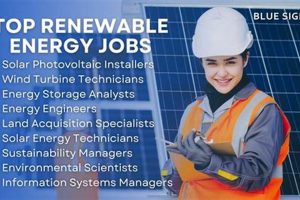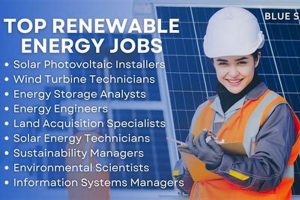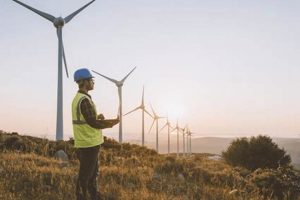Positions within the hydropower sector encompass a wide range of specializations, from engineering and construction to operations and maintenance, as well as environmental science and regulatory compliance. For example, a civil engineer might design a dam, while a biologist might assess the impact of the facility on local fish populations.
Clean energy generation and sustainable resource management are critical for addressing climate change and promoting energy independence. Employment opportunities within this vital sector contribute to economic growth in communities near hydropower facilities and support the development of essential infrastructure for future generations. The industry has evolved significantly since the first hydroelectric plants were built, incorporating advancements in technology and environmental stewardship.
This article will further explore specific career paths within the hydropower industry, highlighting required skills, education levels, and potential career progression. Additional topics include current industry trends, challenges, and future projections for employment in this dynamic field.
Tips for Pursuing Careers in Hydropower
The following tips offer guidance for individuals interested in pursuing employment within the hydropower sector.
Tip 1: Develop a Strong Foundation in STEM. A solid understanding of science, technology, engineering, and mathematics is essential for many roles within the industry. Focusing on these subjects during secondary education can provide a valuable foundation for future studies and career development.
Tip 2: Consider Specialized Training or Education. Many positions require specific training or advanced degrees. Researching various career paths within the industry and identifying necessary qualifications can help individuals make informed educational choices. Examples include engineering degrees, environmental science programs, or vocational training in areas like welding or electrical work.
Tip 3: Gain Relevant Experience. Internships, co-op programs, or entry-level positions can provide valuable practical experience and increase marketability to potential employers. Seeking opportunities with hydropower companies or related organizations can offer valuable exposure to the field.
Tip 4: Network with Industry Professionals. Attending industry conferences, joining professional organizations, and connecting with individuals working in hydropower can provide insights into career opportunities and industry trends. Networking can also lead to mentorship and potential job leads.
Tip 5: Research Industry Trends and Challenges. Staying informed about current developments, such as advancements in hydropower technology or emerging environmental regulations, is essential for career advancement. Understanding industry challenges can also help individuals identify areas where their skills and expertise can be applied.
Tip 6: Emphasize Relevant Skills. When applying for positions, highlight skills such as problem-solving, analytical thinking, teamwork, and communication, which are highly valued within the industry. Tailoring resumes and cover letters to specific job requirements can increase the likelihood of securing an interview.
By following these tips, individuals can increase their competitiveness in the hydropower job market and contribute to a sustainable energy future.
This information provides a solid foundation for those interested in pursuing a fulfilling career in hydropower. The following section will conclude with a discussion of the long-term outlook for employment in this important sector.
1. Engineering
Engineering disciplines are fundamental to the hydropower sector. Civil engineers design and oversee the construction of dams, powerhouses, and other related infrastructure. Their expertise ensures structural integrity and efficient water management. Mechanical engineers contribute to the design and implementation of turbines and generators, optimizing energy conversion. Electrical engineers focus on the integration of power generation equipment with transmission and distribution networks, ensuring reliable delivery of electricity. For example, the Hoover Dam, a marvel of civil engineering, demonstrates the scale and complexity of these projects. The design and implementation of its massive turbines, a feat of mechanical engineering, showcase the crucial interplay between these disciplines. Understanding the engineering principles behind hydropower is essential for ensuring the safety, efficiency, and sustainability of these projects.
Specialized engineering roles, such as hydraulic engineering and geotechnical engineering, further contribute to the successful development and operation of hydroelectric facilities. Hydraulic engineers analyze water flow and manage its impact on dam structures and surrounding environments. Geotechnical engineers assess soil and rock conditions to ensure the stability of foundations and prevent landslides or other geological hazards. The Three Gorges Dam in China, for instance, required extensive geotechnical analysis due to the complex geological conditions of the region. This specialized expertise is crucial for mitigating risks and ensuring the long-term viability of hydropower projects. Practical applications of these engineering principles are evident in the development of innovative solutions, such as fish passage systems and sediment management strategies, aimed at minimizing environmental impact.
In summary, engineering expertise forms the backbone of the hydropower industry, spanning multiple disciplines and contributing to all phases of project development and operation. From initial design and construction to ongoing maintenance and optimization, engineers play a crucial role in harnessing the power of water for sustainable energy generation. Addressing challenges such as aging infrastructure and the integration of hydropower into smart grids requires continuous innovation and collaboration within the engineering community. The ongoing development of advanced technologies and sustainable practices within the hydropower sector underscores the vital link between engineering and a clean energy future.
2. Construction
Construction forms a critical link in the chain of activities required to bring hydroelectric projects from concept to reality. This phase involves a diverse workforce specializing in various trades and skills, including heavy equipment operation, welding, concrete pouring, and structural assembly. The scale and complexity of hydroelectric construction projects often necessitate meticulous planning and coordination across multiple teams. For example, the construction of the Grand Coulee Dam, one of the largest concrete structures in the world, involved a massive workforce and intricate logistical operations. The successful completion of such projects depends heavily on the expertise and experience of construction professionals. This phase not only creates employment opportunities during the project’s lifespan but also lays the foundation for the ongoing operation and maintenance of the facility.
The specialized nature of hydroelectric construction necessitates adherence to stringent safety and quality standards. Working in often challenging environments, such as remote locations or at significant heights, demands rigorous safety protocols and specialized training. Furthermore, the construction process must adhere to precise engineering specifications to ensure the long-term structural integrity and operational efficiency of the hydroelectric facility. For instance, the construction of underground tunnels for water conveyance requires advanced techniques like tunnel boring machines (TBMs) and specialized expertise in ground stabilization. Moreover, sustainable construction practices, such as minimizing environmental impact and sourcing materials responsibly, are increasingly integrated into modern hydroelectric projects. This commitment to sustainability reflects the broader industry trend towards responsible resource management and environmental stewardship.
In conclusion, the construction phase of hydroelectric projects plays a pivotal role in translating engineering designs into operational infrastructure. The expertise of construction professionals, coupled with adherence to rigorous safety and quality standards, ensures the successful delivery of these complex projects. Furthermore, embracing sustainable construction practices contributes to the long-term environmental and economic viability of the hydropower sector. The construction phase therefore represents a crucial investment in sustainable energy infrastructure and provides significant employment opportunities within a rapidly evolving industry.
3. Operations
Operational roles in hydropower are critical for ensuring the continuous and efficient generation of electricity. These roles encompass a range of responsibilities, including controlling water flow through turbines, monitoring power generation equipment, and managing transmission and distribution networks. Skilled operators maintain optimal performance, respond to changing energy demands, and ensure the safety and reliability of the power plant. For example, at a pumped storage hydropower facility, operators manage the complex process of pumping water uphill during periods of low energy demand and releasing it downhill during peak demand, optimizing energy storage and utilization. Effective operation is essential for maximizing the output of the facility and contributing to grid stability. This understanding of the operational aspects is vital for anyone considering employment in the hydropower sector.
Modern hydropower operations increasingly rely on advanced control systems and data analytics. Supervisory Control and Data Acquisition (SCADA) systems provide real-time monitoring and control of various plant parameters, enabling operators to make informed decisions and optimize performance. Predictive maintenance, enabled by data analysis and machine learning, helps anticipate equipment failures and minimize downtime. For instance, vibration sensors on turbines can detect early signs of wear and tear, allowing for timely maintenance and preventing costly breakdowns. These technological advancements enhance operational efficiency, reliability, and safety, while also creating demand for specialized skills in areas like automation and data analysis within the hydropower workforce. This integration of technology underscores the evolving nature of operational roles within the industry and the importance of continuous learning and adaptation.
In summary, the operation of hydroelectric facilities requires a skilled workforce capable of managing complex processes, responding to fluctuating energy demands, and ensuring the safe and efficient generation of clean energy. The increasing adoption of advanced technologies, such as SCADA systems and predictive maintenance, further enhances operational efficiency and creates new opportunities for specialized expertise within the sector. Understanding the operational aspects of hydropower generation is crucial for both aspiring professionals and those seeking a comprehensive overview of the industry. The ongoing evolution of technology and the increasing focus on sustainability highlight the continuing importance of operational excellence within the hydropower sector.
4. Maintenance
Maintenance plays a crucial role in ensuring the longevity, reliability, and safety of hydroelectric facilities. Regular inspections, preventative maintenance, and timely repairs are essential for optimizing performance and minimizing downtime. These tasks encompass a wide range of activities, including inspecting and servicing turbines, generators, transformers, and other critical components. For instance, regular lubrication of rotating parts and the replacement of worn seals can prevent significant damage and extend the operational lifespan of equipment. Specialized technicians and mechanics with expertise in hydraulic systems, electrical systems, and mechanical systems are essential for performing these maintenance tasks. Neglecting maintenance can lead to costly repairs, reduced energy output, and potentially catastrophic failures, emphasizing the critical importance of this aspect of hydroelectric operations.
The challenging environments often associated with hydroelectric facilities, such as exposure to water, humidity, and extreme temperatures, can accelerate wear and tear on equipment. Therefore, maintenance strategies must be tailored to the specific conditions of each facility. For example, facilities located in cold climates may require specialized maintenance procedures to prevent freezing damage during winter months. Furthermore, underwater inspections of dam structures and intake systems are crucial for identifying potential issues like cracks or corrosion, which can compromise structural integrity. Modern maintenance practices increasingly incorporate advanced technologies, such as non-destructive testing (NDT) and remote sensing, to improve the accuracy and efficiency of inspections. These technologies allow for early detection of potential problems, enabling proactive maintenance and preventing more extensive damage. This integration of technology further emphasizes the evolving nature of maintenance roles and the increasing demand for specialized skills within the hydropower sector.
In conclusion, effective maintenance is essential for maximizing the operational lifespan, reliability, and safety of hydroelectric facilities. Skilled maintenance personnel, employing both traditional techniques and advanced technologies, play a crucial role in ensuring the continued and efficient generation of clean energy. Addressing the specific challenges posed by the operating environment and incorporating preventative maintenance strategies are key to optimizing performance and minimizing downtime. The ongoing development of new technologies and maintenance practices further underscores the importance of this function within the hydropower industry and its contribution to a sustainable energy future. The connection between skilled maintenance professionals and the long-term success of hydroelectric operations remains vital for meeting future energy demands.
5. Environmental Science
Environmental science plays a critical role in the hydropower sector, ensuring the sustainable and responsible development and operation of hydroelectric facilities. Environmental scientists and specialists conduct environmental impact assessments (EIAs) to evaluate the potential effects of a project on surrounding ecosystems. These assessments consider factors such as water quality, fish migration patterns, and terrestrial habitats. Mitigation strategies are developed and implemented to minimize negative impacts, which might include the construction of fish ladders to facilitate migration or the restoration of riparian habitats. For example, the construction of the Itaipu Dam on the Paran River involved extensive environmental studies and the implementation of a comprehensive biodiversity conservation program. This program aimed to protect endangered species and mitigate the impact of the dam on the surrounding rainforest ecosystem. The integration of environmental science into hydropower projects is essential for balancing energy production with ecological preservation.
Ongoing monitoring and research are essential components of environmental management in hydropower. Scientists collect data on water quality, fish populations, and other environmental indicators to track the long-term effects of hydropower operations. This data informs adaptive management strategies and ensures that mitigation measures remain effective. For instance, ongoing monitoring of dissolved oxygen levels downstream of a dam can help identify potential impacts on aquatic life and inform adjustments to water release protocols. Furthermore, research on fish passage technologies and innovative mitigation strategies continually evolves, contributing to improved environmental performance within the hydropower sector. The commitment to ongoing monitoring and research demonstrates the industry’s dedication to responsible environmental stewardship and its recognition of the complex interplay between hydropower and the environment.
In summary, environmental science is integral to the sustainable development and operation of hydroelectric projects. From initial environmental impact assessments to ongoing monitoring and research, environmental professionals play a crucial role in minimizing negative impacts and ensuring the long-term health of surrounding ecosystems. The incorporation of scientific expertise and data-driven decision-making contributes to a balanced approach that considers both energy needs and environmental protection. Addressing challenges such as climate change and increasing water scarcity necessitates continued innovation and collaboration between environmental scientists and the hydropower industry. The integration of environmental science into hydropower not only protects valuable ecosystems but also contributes to the long-term viability and social acceptance of this important renewable energy source.
Frequently Asked Questions
This section addresses common inquiries regarding employment within the hydropower sector.
Question 1: What types of educational backgrounds are typically required for positions within the hydropower industry?
Positions within the hydropower industry span a wide range of educational requirements, from vocational training certificates for certain skilled trades to advanced engineering degrees for specialized roles. Technical positions often require associate’s or bachelor’s degrees in fields such as mechanical, electrical, or civil engineering. Scientific and environmental roles may necessitate degrees in biology, ecology, or environmental science.
Question 2: What is the typical career progression within the hydropower sector?
Career progression within the hydropower sector often begins with entry-level positions or internships, providing opportunities to gain practical experience. As individuals develop their skills and expertise, they may advance to supervisory or management roles. Continued professional development and specialized certifications can further enhance career prospects.
Question 3: How does the hydropower industry address safety concerns associated with working in potentially hazardous environments?
Safety is paramount within the hydropower industry. Stringent safety protocols are implemented throughout all phases of project development and operation. Regular safety training, specialized equipment, and adherence to industry best practices help mitigate risks and protect workers. These protocols address potential hazards associated with working at heights, underwater operations, and high-voltage electrical equipment.
Question 4: What is the long-term job outlook for the hydropower sector?
The long-term job outlook for the hydropower sector is generally positive, driven by the increasing global demand for renewable energy sources. Growth potential exists in both developed and developing countries, with opportunities in areas such as dam construction, operations and maintenance, and environmental management. However, specific regional factors, such as government policies and economic conditions, can influence employment trends.
Question 5: How does the hydropower industry contribute to local communities?
Hydropower projects often contribute to local communities through job creation, tax revenue, and improved infrastructure. These projects can stimulate economic development in rural areas and provide access to clean and affordable electricity. Furthermore, many hydropower companies engage in community outreach programs and support local initiatives.
Question 6: What role does innovation play in the future of hydroelectric employment?
Innovation plays a key role in shaping the future of hydroelectric employment. Advancements in areas such as hydropower technology, environmental mitigation strategies, and data analytics create new opportunities for specialized skills and expertise. The ongoing development of smart grids, pumped storage hydropower, and advanced materials will further influence future employment trends and necessitate continuous learning and adaptation within the workforce.
Understanding these key aspects of employment within the hydropower industry can help individuals make informed career decisions and contribute to a sustainable energy future.
The following section will explore specific career paths within the hydropower sector, providing detailed information on required skills, education levels, and potential career progression.
Hydroelectric Jobs
This exploration of employment opportunities within the hydropower sector has highlighted the diverse range of roles, from engineering and construction to operations, maintenance, and environmental science. The importance of skilled professionals in each of these areas has been underscored, emphasizing their contribution to the safe, efficient, and sustainable generation of clean energy. Furthermore, the evolving nature of the industry, driven by technological advancements and increasing environmental awareness, necessitates continuous learning and adaptation within the hydropower workforce.
The hydropower sector offers significant potential for those seeking careers that contribute to both a sustainable energy future and economic development. As the global demand for clean energy continues to grow, the need for qualified professionals in hydropower will remain crucial. Continued investment in education, training, and research will be essential for ensuring a robust and skilled workforce capable of meeting the challenges and opportunities of this dynamic industry. The future of hydropower relies on attracting and retaining talent dedicated to harnessing the power of water for generations to come.







